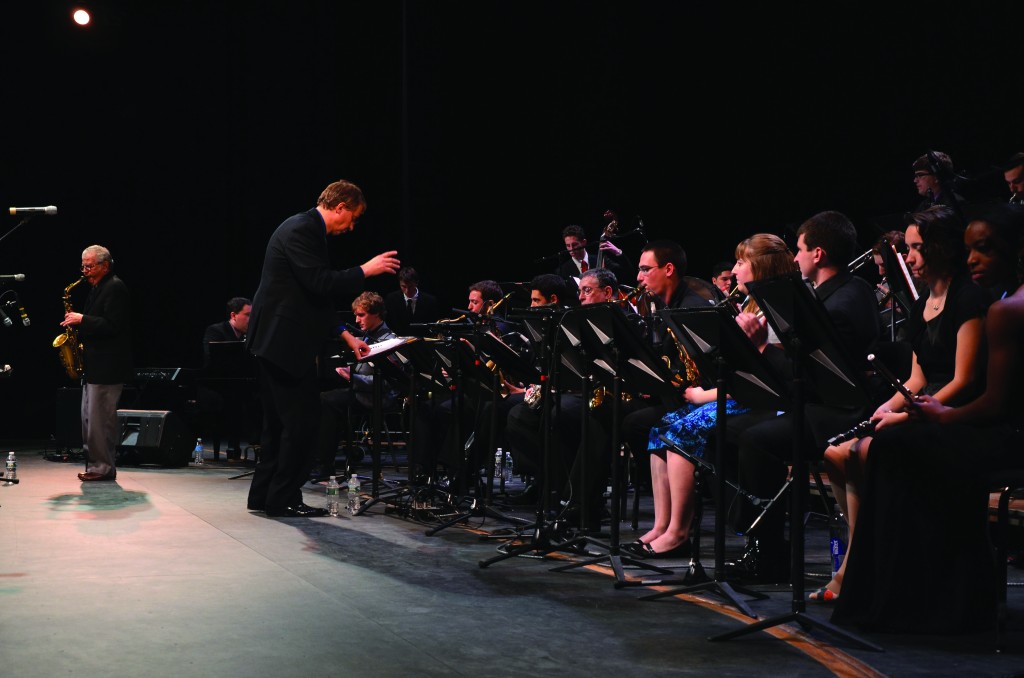
The Harpur Jazz Ensemble jazzed up the Osterhout Concert Theater on Thursday night with award-winning jazz artist Joe Riposo, who’s played in house bands with Sammy Davis Jr., Nat King Cole and Ella Fitzgerald.
The two-hour concert was free for students and was directed by Michael Carbone, director of Binghamton University’s jazz studies program. Carbone is the saxophonist in the popular local jazz quartet, Miles Ahead. The program also featured performances from Harpur Vocal Jazz, a student-run group.
The second half of the concert featured performances by Riposo, who, after 28 years, recently retired from his position at Syracuse University as director of jazz studies. Carbone met Riposo when he joined Riposo’s jazz ensemble while attending community college.
“[Riposo] helped me eventually get into the university I wanted to attend,” Carbone said.
When Riposo first walked on the stage, the audience saw an unassuming older gentleman carrying a saxophone, but by the time he walked off, they saw a master in his element.
“I’ve had the opportunity to go across the country and play with many college bands; this band is one of the finest,” Riposo said. “They make me feel like I’m 20 years old again.”
Harpur Vocal Jazz opened with the first number, a beautifully executed rendition of “The Star-Spangled Banner” that had the generous attendance of approximately 150 people standing with hands over their hearts.
The program proceeded with the ensemble coming on stage and Mo “Reese” Taylor on piano. First was Thelonious Monk’s “Straight, No Chaser,” which started the set on an abrupt note, thrusting the audience into the performance.
“It’s one of those comfortable songs you can just sit back and enjoy,” Carbone said.
The song featured several solo improvisations by members of the ensemble, which sounded natural during the performance. The music was consistently balanced between all of the performers, and Carbone did an excellent job making sure that there were always microphones on the soloists, adjusting even while conducting the entire ensemble.
The second song was “Blue Skies,” sung by the ensemble’s new vocalist, Inez Nelson, who promised “nothing but blue skies, from now on.” The third song of the set, “Chelsea Bridge,” slowed down the performance with a relaxing rhythm and easy sounds, perfectly setting the mood for “Aja,” a song originally written for Steely Dan (as part of their Grammy-winning album of the same name). The final piece in the set was “The Jazz Police,” which sounded like an exciting police investigation and ended the first half of the performance.
The second set consisted of, in order of performance, “Blue Bossa,” “Blue,” “Laura,” “Body and Soul” and, finally, “Blues for the Cause.” The last was written by Riposo himself. When a soloist would finish his or her improv, Riposo and Carbone would often turn to the rest of the ensemble and give them encouraging gestures. Accompanying Riposo was Dave Solazzo, Riposo’s right-hand man on piano. Riposo would comment that he and Solazzo are “married musically,” as his background piano gives Ripsoso the comfort and freedom to play whatever he wishes.
By the end of the show, the jazz moved many in the audience to clap along and dance in their seats. The performance ended in a standing ovation.
“Riposo is like an older Sergio Flores, but better,” said Peter Devlin, a freshman majoring in computer science.


